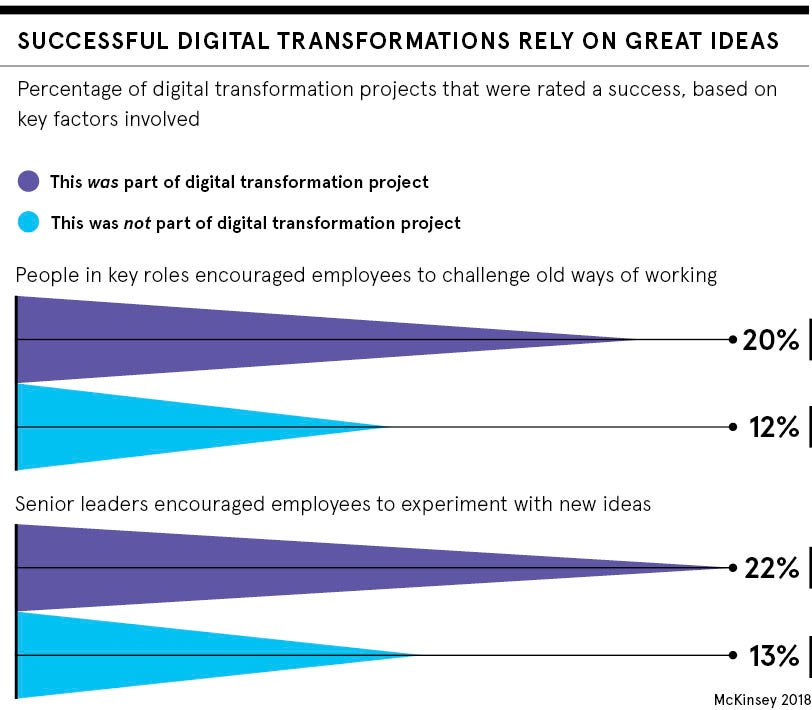Generating innovative ideas and turning them into real opportunities is challenging for businesses, especially big ones, and particularly now with dispersed workforces. A pandemic of Zoom and Teams has seen digital collaboration and employee engagement on a scale unheard of a year ago. It’s no surprise then that in a coronavirus-conscious world, idea management software is also booming.
“This feels like a zeitgeist moment for our sector. When the whole globe suddenly started working from home, those with the online tools to collaborate seamlessly across borders and locations were more prepared for the new world order,” says Simon Hill, chief executive of collaboration software outfit Wazoku.
The sector’s come a long way. At the turn of the millennium, rudimentary digital idea management tools began to appear, evolving from the traditional employee suggestion box. The 2008 financial crash and subsequent recession instilled a healthy fear of disruption in large organisations, fuelling accelerated evolution in the sector. Now the market’s worth nearly $1 billion, growing at 13 per cent a year, and for good reason; the Dragons’ Den of early ideas can become business winners.
“One of the most important differentiators between idea management and other social collaboration tools is it allows companies to quantify and measure all aspects of innovation, from engagement to user activity and return on investment,” says Eran Tsur, vice president of marketing at Qmarkets.
The tech allows companies to quantify and measure all aspects of innovation, from engagement to user activity and ROI
With the stand-up team meeting, water-cooler chat, live workshops and bustling hackathons paralysed by the coronavirus pandemic, the wisdom of the corporate crowd is now being orchestrated online. Idea management software has also been used as a crucial employee engagement tool in lockdown, as some companies try to recalibrate and pivot their whole business model. As the economic fallout ensues, the software is proving invaluable.
“Right now, there’s a real need to invest in structured programmes that accelerate change and create more resilient and flexible companies, as well as fostering reinvention in a systematic way,” says Diana Carvalho, chief executive of Exago.
It’s assisting real people
However, idea management software doesn’t build a culture of business innovation; that’s the job of real people. Creativity also demands a level of human spontaneity and time to think, rather than a chatbot telling staff how to innovate.
What software is good at is digitalising and formalising the process. It collates thousands of ideas, tests and discusses them at scale, then gathers the human, financial and logistical means to make the best ideas come to life and eventually impact the bottom line.
“Culturally, it can sometimes require some effort to get employees and idea communities to buy into using software for innovation, but on the whole people really embrace it. They feel empowered that their opinion is sought and engagement levels can be very high indeed,” says Wazoku’s Hill.

“John Lewis & Partners has been using our software for several years now and has seen more than 4,000 staff ideas submitted, many from the shop floor, with innovation realising £10 million in annual cost-savings. This technology really works and can make a tangible difference.”
HSBC, Waitrose, Hyundai, Nestlé, Intel and the NHS are just some of the employers using this class of software; the list is diverse and the size of organisations varies. What’s consistent with many is COVID-19 has been a rallying call for crowdsourcing fresh ideas from engaged employees.
“Some of our customers’ COVID-19 challenges have brought the highest-ever number of employees on board, one of which gathered more than 400 ideas in just 24 hours,” says Doug Williams, principal innovation consultant at Planview. “Crowdsourcing employee ideas right now and post-pandemic is essential, since staff are on the frontline with customers, partners and company processes.”
The Amazon of ideas
One of the greatest strengths in deploying a digital innovation platform, of which there are a good handful, is their ability to get many more employees actively involved. Everyone likes to be asked about their ideas. Many find it flattering and it makes workers think they’re not just a small cog in a big wheel. “Millennials and generation Z expect employee engagement initiatives like these; it ensures their retention,” says Carvalho at Exago.
Idea management software is also starting to engage employees with a new layer of tech: artificial intelligence (AI). It can help match the most relevant worker to a challenge or identify duplicate ideas using natural-language processing, as well as improve efficiency. AI also helps make innovation management more efficient. It can feed algorithms enabling businesses to analyse and interpret complex information; that way employees can detect trends and customer expectations faster.

Expect greater augmentation going forward, though the future is mostly uncharted. “AI mainly helps people save time, however in the future we see it having an increasingly prominent role to play across the entire spectrum of innovation management activities,” explains Qmarkets’ Tsur.
Beyond AI, the next frontier is an increased willingness for organisations to look externally for ideas and inspiration. Digital platforms can assist in this process providing structure. It’s why Bristol-based Wazoku just acquired InnoCentive, a US firm with a global network of 500,000 expert problem-solvers, including chief executives, PhD students, engineers, scientists, entrepreneurs, retired technologists and business leaders.
“Those firms adopting open ways of working, both inside their organisational walls and in the way they use outside talent to augment change and innovation, will adapt quicker and change faster,” Hill concludes. Amazon-like marketplaces for innovative thinking might just engage a lot more of us.
It’s assisting real people

The Amazon of ideas

